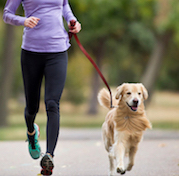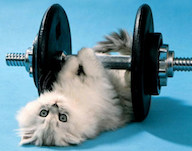-
Exercise, Aerobic and
Anaerobic.
Definitions and
Benefits.
Movement of the body -
exercise - creates a domino effect. Exercise
fundamentally changes and effects every system in
your body. Exercise is not about 'looking' good',
it's about staying alive, being healthy, oxygenation of the cells, and
detoxification of the body.
Unexpected motivation to
exercise!

Basically, if
you don't move your body, you die. Stretch, walk, skip, jog, run,
hike, dance, hulahoop, swim, surf, bike, do
Tai Chi or yoga ... just MOVE!
What is Exercise:
Definition - "Exercise is
physical activity that is planned, structured, and
repetitive for the purpose of conditioning any
part of the body. Exercise is used to improve
health, maintain fitness and is important as a
means of physical rehabilitation". - medical-dictionary.thefreedictionary.com
Physical movement
creates supplemental oxygen
and stimulates the lymphatic
system. The degree of physical activity
determines the extent of benefits and the impact to
the mind and body.
Explanation -
Movement activates circulation which drives blood
through the body, forcing oxygen and nutrition. The
lymph system, the body's sewage system which has no
pump, is also forced to work. Without
movement the lymph becomes stagnant and
you literally begin to
poison yourself over time.
"Without daily
physical movement the Lymphatic System cannot detox
your body. Aerobic exercise gives oxygen to the
tissues and moves the lymph around. Lymph is a
colorless fluid that bathes every cell in the body.
The body has two
circulatory systems, one for blood and the other for
lymph. Blood is circulated by the heart, whereas the
lymph is circulated by physical exercise. Many
tissues depend on the lymph to provide nutrients
(including oxygen) and carry off wastes.
If the lymph does
not circulate then the tissues suffocate while
stewing in their own acidic waste products (uric
acid, lactic acid etc.)." - Extract from Acid
and Alkaline Food.
The longer you
are sedentary, the sicker you become, disease sets
in. You feel miserable. You gain weight. You
experience pain daily. You begin to take drugs.
Then you take more drugs to counteract the initial
drugs.
The cycle of
disease predictably spins out of control. You end
up so dependent on the drugs, you just don't care
anymore, and you don't have the energy to stop the
cycle ... or do you?
Physical
activity maintains and improves health and
fitness, builds endurance, delays aging, changes
ones physiology thus improving mental and
emotional states, assists sleep and is used for
physical rehabilitation and wellness.
Specific Exercise Benefits:
- Reduction in the risk of coronary
artery disease.
- Reduction in the risk of developing high blood
pressure (hypertension).
- Blood fat
improvement - decrease LDL 'bad' cholesterol and
increase HDL 'good ' cholesterol.
- Reduction in risk
of stroke - Improving blood fats reduces plaques
deposit in arteries.
- Reduction in risk
of developing type 2 diabetes
- Weight control via exercise reduces chances of obesity
- which can lead to diabetes.
- Immune system
activation - regular exercise wards off
susceptibility to viruses.
- Improved blood circulation.
- Build strong bones - reduces risk of osteoporosis.
- Change in mental and emotional state
- a change in physiology immediately changes
one's mood and focus.
- Boost natural
life force energy known as Chi.
- Relief from muscle pain and fibromyalgia
- exercise stimulates the growth of tiny blood
vessels (capillaries) in the muscles. This enables
the body to deliver oxygen to the muscles more
efficiently and remove irritating metabolic waste
products, such as lactic acid.
- Information gathered from the Mayo
Foundation for Medical Education and Research.
What is Passive Exercise:
Definition - Movement applied to the body or
a body part, by another person or persons
(physiotherapy), or via a motion machine.
When a passive range
of motion is applied, the body or body part (arm,
leg, head, ankle, wrist, knee), of the individual
receiving the passive exercise is completely
relaxed, while the outside force moves the body part
throughout the available range of motion. A
repetitive movement.
Benefits
those who hate to exercise, those who are short on
time, those who prefer to exercise at home or on a
lunch-break, those who dislike the body being
stressed and jarred by more vigorous activity, those
who need to relax and de-stress, those who are
frail, sick, bedridden or elderly, and regardless of
weather conditions outside. No risk of injury.
Activities
include massage, gentle physiotherapy, and the
Original Chi Machine (find one on eBay).
Aerobic
Respiration:
1)
Respiration is
the process by which an organism takes oxygen into
its body and then releases carbon dioxide from its
body.
2) Aerobic Respiration:
Respiration that requires the presence of oxygen.

Aerobic exercise,
the foundation of health.
What is Aerobic Exercise:
Definition - Exercise during which oxygen is
metabolized to produce energy.
Physical activity,
sustained period of time, sometimes long in
duration, low in intensity - rhythmic and repetitive
for the purpose of conditioning or strengthening any
part of the body.
Aerobic means "with oxygen".
Aerobic activity continually supplies enough oxygen
for the duration of the activity.
Benefits -
Aerobic exercise conditions the heart, blood vessels
and cardiovascular system (lungs), increasing the
oxygen available to the body and by enabling the
heart to use oxygen more efficiently. Regular
aerobic exercise releases endorphins, the body's
natural painkillers - also induces an emotional
'high'.
Increased oxygen and
blood flow to the brain creates mental focus.
Stimulation of lymphatic
system is critical and promotes
elimination of metabolic waste and toxins.
Activities
include rebounding, bicycling, brisk walking,
dancing, swimming, rowing, soccer, skating and
cross country skiing.
Aerobic
Activity is either Low Impact or High Impact:
Low Impact - One foot always
stays on the floor and supports the weight of the
body. e.g. Walking, stair climbing.
High-impact
- Include actions that take both feet off the
floor, thus causing more jarring of the joints
when the body weight hits the floor again. e.g.
Jumping, jogging, skipping
FYI:
Sports cause sore muscles due to lactic acid build
up which can be dissipated via passive aerobic
exercise.

For those who want muscles.
Anaerobic Exercise:
Definition - Anaerobic means "without
oxygen". Physical activity short in
duration, high in intensity.
General level of intensity is too great to allow
enough oxygen into the body to burn fat for energy.
The body then switches to burning stored fuels such
as glycogen and small amounts of carbohydrate stored
in muscles. Since we only store about 2 minutes
worth of anaerobic energy, anaerobic activity
usually lasts a short time or becomes stop and go as
we tire faster.
Benefits
- Anaerobic benefits determine how well a workout
strengthens and develops muscles.
Anaerobic activities includes weight lifting,
racquetball, downhill skiing, tennis, martial arts
and sprinting.
Summary:
There is no substitution for getting your body up
and moving daily via such activity as walking,
swimming, biking, jogging, hiking, tennis,
basketball or even lifting weights or walking a
treadmill.
However, due to physical challenges, illness, age
limitations, time restrictions, and weather
factors, many people simply cannot or do not get
their body moving everyday. Many people spend
their day commuting, working, raising a family,
sitting in front of a computer or TV, scrolling
through the cell phone, or sleeping. Are you one
of them?
How about you put on YouTube and find videos where
you can get your body moving without having to
leave home - yoga, Tai Chi, dance, shadow boxing,
pilates, tailored home workouts ...
If you can balance, a mini trampoline will get
your circulation going, oxygenate, and stimulate
your lymphatic system to detox.




